
95% of researchers rate our articles as excellent or good
Learn more about the work of our research integrity team to safeguard the quality of each article we publish.
Find out more
ORIGINAL RESEARCH article
Front. Vet. Sci. , 22 July 2022
Sec. Animal Reproduction - Theriogenology
Volume 9 - 2022 | https://doi.org/10.3389/fvets.2022.875810
This article is part of the Research Topic Cryopreservation of Mammalian Gametes and Embryos: Implications of Oxidative and Nitrosative Stress and Potential Role of Antioxidants View all 6 articles
 Yue Wang1†
Yue Wang1† Yusheng Qin2†
Yusheng Qin2† Wei Zhao1†
Wei Zhao1† Fusheng Yao1
Fusheng Yao1 Wenjing Wang1
Wenjing Wang1 Xiao Hu1
Xiao Hu1 Linghua Cheng1
Linghua Cheng1 Lei An1
Lei An1 Jianhui Tian1*
Jianhui Tian1*Sildenafil, a phosphodiesterase 5 (PDE-5) inhibitor, provides an alternative and effective strategy to increase uterine blood flow and vascular development, thus improving fetal development. Previous studies have shown that sildenafil attenuates fetal growth restriction in rodents, sheep, and humans. However, the effect of sildenafil intervention on fetal growth in pigs remains unclear. This study aims to evaluate the effect of dietary supplementation with sildenafil on the reproductive performance of sows and gilts. Over 700 Landrace × Large White crossbred sows in the 3rd or 4th parity were randomly assigned to the control group and the sildenafil treatment groups. In brief, sows in the treatment groups were given a basic diet supplemented with sildenafil (0.32 g/day) during different stages of gestation: (1) gestation day (GD) 0–110; (2) GD 0–30; (3) GD 30–80; (4) GD 80–110; and (5) GD 30–110. At parturition, the total number of piglets born per litter, the number of piglets born alive or dead, the average birth weight, the number of weaned piglets, and the average weaning weights were recorded and analyzed. Sildenafil supplementation throughout gestation (GD 0–110) increased both the litter size and the average birth weight. To reduce the cost of extended sildenafil supplementation, time-phased strategies were further tested. Sildenafil supplementation during early gestation (GD 0–30), mid-gestation (GD 30–80), and late gestation (GD 80–110) partially improved litter performance. Notably, sows fed sildenafil supplementation from the mid-to-late gestation period (GD 30–110) showed significantly improved litter performance, approaching the levels in the sows supplemented with sildenafil throughout the whole gestation period. Taken together, our results showed that maternal sildenafil supplementation during gestation can effectively improve the reproductive performance of sows and gilts, and enhance the growth performance of neonatal piglets, thus providing a promising and practical intervention strategy to improve reproductive management in pig farming.
The production of piglets by sows significantly influences the economic benefits of pig farming. However, the reproductive performance of sows is frequently unsatisfactory because of many environmental, nutritional, and pathological factors (1–3). In particular, the maternal uterine status during gestation is essential for good reproductive performance, such as the litter size, the number of piglets born alive or dead, as well as the growth performance of neonatal piglets, including their birth weight and weaning weight (4–7). In addition, suboptimal uterine status has been reported to be highly associated with the occurrence of birth defects and stillbirths. Thus, intervention to improve the maternal uterine status is a potential strategy to enhance reproductive performance and neonatal growth.
Sildenafil, a phosphodiesterase 5 (PDE-5) inhibitor that blocks cyclic guanosine monophosphate (cGMP) hydrolysis, thereby enhancing nitric oxide (NO)-dependent vasodilatation. It provides an alternative and effective strategy for improving the uterine status and fetal growth, because increased uterine cGMP levels can increase uterine blood flow and vascular development (8). In addition to evidence demonstrating the efficacy of sildenafil in improving fetal growth, particularly in rodents (9–12), clinical reports also showed that sildenafil could improve uterine blood flow, alleviate severe early-onset intrauterine growth restriction, and improve maternal blood pressure regulation during preeclampsia pregnancies (13–17). Long-term administration of sildenafil citrate enhanced fetal weight in both adequately fed and nutrient-restricted ewes (18). However, the efficacy of sildenafil intervention in terms of fetal growth in sows or gilts remains undetermined.
In the present study, we evaluated the efficacy of dietary sildenafil supplementation during gestation in terms of improving the reproductive performance of sows and gilts. We designed a series of experiments in which diets were supplemented with sildenafil at various stages of gestation. The results indicated that maternal sildenafil supplementation during gestation can effectively improve the reproductive outcomes of sows and gilts, and enhance the growth performance of neonatal piglets, thus providing a promising and practical intervention strategy to improve reproductive management in pig farming.
This study was performed between June and November. More than 700 Landrace × Large White cross-bred sows with an initial body weight of 138.23 ± 6.34 kg were used in this study. All animals (sows, gilts, and piglets) were raised by Muyuan Food Co., Ltd. (Henan, China), which uses a large-scale intensive raising model. The animals were housed under uniform feeding and housing conditions. The 2–3-year-old sows in the 3rd and 4th parity, as well as 230-day-old gilts with weights ranging from 120 to 130 kg, were randomly divided into control or treatment groups (Figure 1). The sows in the control group fed with a standard grain-based diet. The sows in the sildenafil-supplemented group were given a basic diet supplemented with sildenafil (0.32 g/day; Wuhan Remote Co-creation Technology Co., LTD, Wuhan, China) (19) during different stages of gestation: (1) GD 0–110; (2) GD 0–30; (3) GD 30–80; (4) GD 80–110; and (5) GD 30–110. During the afternoon feed, 5 ml of soy oil containing 0.32 g of sildenafil or not was administered to sows using a veterinary filling gun applicator.
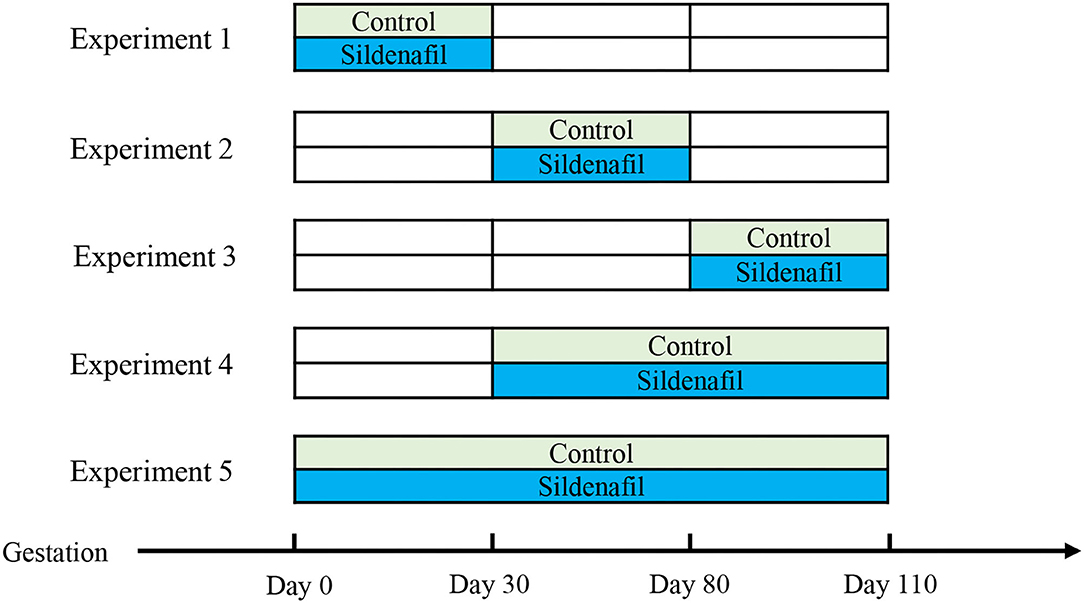
Figure 1. Schematic representation of the experimental design based on the different timing of sildenafil supplementation during gestation.
Sows were transferred into the farrowing units, 1 week before the expected date of parturition. The sows were raised in a warm and quiet environment, and any abnormal behavior was recorded. At farrowing, litters with no piglets born alive were excluded. Immediately after completion of farrowing, the numbers of total piglets born and born alive were registered for each sow. In addition, the numbers of expelled mummified piglets (mummies) and stillborn piglets were also determined. Within 24 h of farrowing, after initial colostrum consumption, each individual live piglet was identified with an inimitable ear tag and weighed using electronic scales. The individual body weights of the piglets were recorded. Data from these piglets were used to derive the litter traits of the sow, such as the total number of born piglets, total litter birth weight, and piglet average birth weight.
This study involved 4,076 and 5,193 piglets born alive from the control and sildenafil groups, respectively. About 10 days after birth, all piglets received creep feed during the last week of the lactation period to acclimatize them to dry food. At weaning, performed at around 27 days old, each piglet that survived the suckling period was weighted using electronic scales to record piglet weaning weights. The litter weaning weight and piglet average weaning weight were calculated according to the individual piglet weaning weights.
All data analyses were conducted using the Statistical Program for Social Sciences, SPSS 20.0 (IBM Corp., Armonk, NY, USA). Individual sows served as the experimental unit. The least significant difference (LSD) test was used to compare the least-squares means. The pooled standard deviation (SD) was calculated for each measurement. A probability of p < 0.05 was considered significant, and 0.05 < p < 0.1 was declared as a trend. For litter performance, the data of the litter weight, the average piglet weight at birth and weaning, and the average daily gain of piglets were analyzed using the default normal linear regression model. Count data, such as the number of total piglets born, born alive, after cross-fostering, death, and weaned piglets, were analyzed using a Poisson regression model, while a zero-inflated Poisson regression model was used to analyze the numbers of stillborns and mummies. Furthermore, a binomial regression model was used to analyze preweaning piglet mortality.
To determine whether dietary sildenafil supplementation throughout the whole gestation period of sows has a beneficial effect on litter performance, 148 sows were fed the sildenafil diet from GD 0 to GD 110. At farrowing, sows in the sildenafil-supplemented group gave birth to more live piglets than those in the control group. In addition, the sildenafil-supplemented group had a greater litter birth weight and showed a significant increase in the average birth weight of the piglets born alive (Table 1).
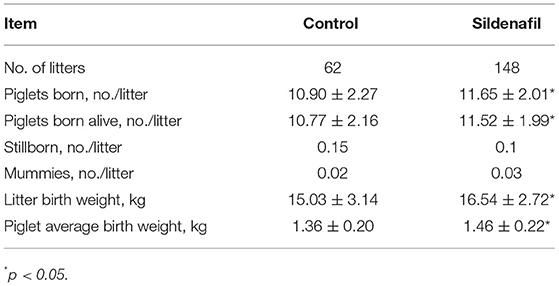
Table 1. Effect of sildenafil intervention from day 0 to 110 of gestation on sow litter performance (means ± SD).
To reduce the cost of prolonged sildenafil supplementation, we designed a series of time-phased strategies and tested the litter performance of sows. First, we assessed the effect of sildenafil intervention on reproductive performance and neonatal growth during the first trimester of gestation. Then, 46 sows were given the basic diet supplemented with sildenafil (0.32 g/day) from GD 0 to GD 30. At farrowing, the total number of born piglets and the litter birth weight were higher in the sildenafil supplementation group than in the control group. It should be mentioned that GD 0–30 sildenafil intervention tended to increase the number of piglets born alive, although the difference was not statistically significant (Table 2). Collectively, these results indicate that dietary sildenafil supplementation during early gestation of sows has beneficial effects on the total number of piglets born and the litter birth weight.
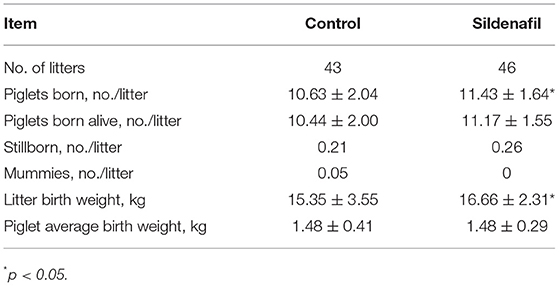
Table 2. Effect of sildenafil intervention from day 0 to 30 of gestation on sow litter performance (means ± SD).
To further explore the effect of sildenafil intervention during mid-gestation on litter performance, 76 sows were given the basic diet supplemented with sildenafil (0.32 g/day) from GD 30 to GD 80. At farrowing, the total number of piglets born, the number of piglets born alive, and the number of weaned piglets were significantly higher in the sildenafil group than in the control group. In addition, sildenafil supplementation significantly increased the litter birth weight. Compared with those in the control group, stillbirths, mummies, and weak births were not affected by sildenafil supplementation (Table 3). These results showed that dietary sildenafil supplementation during mid-gestation of sows has beneficial effects on the litter birth weight and piglets born alive, but not on the total number of piglets born.
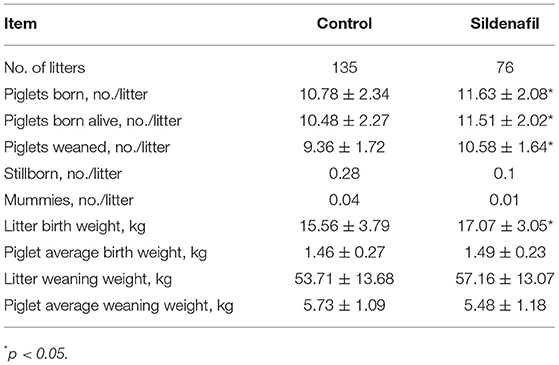
Table 3. Effect of sildenafil intervention from day 30 to 80 of gestation on sow litter performance (means ± SD).
To further investigate the effect of sildenafil intervention in the last trimester of gestation on litter performance, 116 sows were given the basic diet supplemented with sildenafil (0.32 g/day) from GD 80 to GD 110. Sildenafil intervention during late gestation significantly increased the litter birth weight and the piglet birth weight, but not the number of piglets born (Table 4).
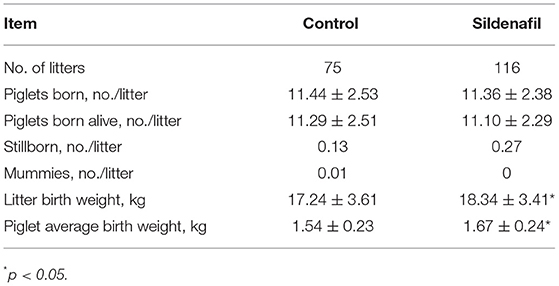
Table 4. Effect of sildenafil intervention from day 80 to 110 of gestation on sow litter performance (means ± SD).
Having confirmed the effect of dietary supplementation of sildenafil on sow litter performance at the early-, mid-, and late-gestation periods, we next attempted to further confirm the effects of dietary sildenafil supplementation on sow litter performance during mid-to-late gestation period. In total, 51 sows were given the basic diet supplemented with sildenafil (0.32 g/day) from GD 30 to GD 110. There was no difference in the piglet birth weight between the sildenafil group and the control group. However, sildenafil supplementation significantly increased the number of piglets born alive, as well as the number of piglets weaned. This advantage in piglets born alive continued through the weaning age at 28 days (p < 0.05). Our results indicated that dietary sildenafil supplementation during mid-to-late gestation of sows significantly increased the litter birth weight, without reducing the piglet average birth weight (Table 5). Taken together, the above results suggest that dietary sildenafil supplementation during mid-to-late gestation is an economical and effective strategy to improve the reproductive performance of sows.
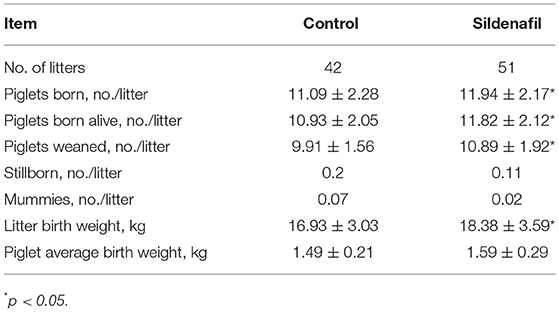
Table 5. Effect of sildenafil intervention from day 30 to 110 of gestation on sow litter performance (means ± SD).
Next, we assessed the beneficial effect of dietary sildenafil supplementation during mid-to-late gestation is common in gilts. To this end, 19 gilts were given the basic diet supplemented with sildenafil (0.32 g/day) from GD 80 to GD 110. Gilts in the sildenafil-supplemented group had more piglets born alive than those in the control group. In addition, the litter birth weight and the average birth weight were higher in the sildenafil group than in the control group (Table 6). Thus, we concluded that dietary sildenafil supplementation is helpful in increasing the litter size of gilts.
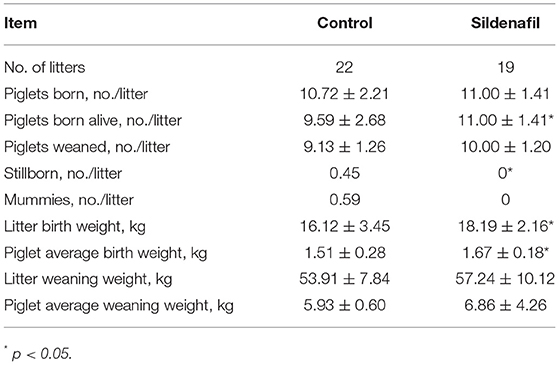
Table 6. Effect of sildenafil intervention from day 30 to 110 of gestation on gilt litter performance (means ± SD).
The reproductive performance of sows and gilts and the growth performance of neonatal piglets are the critical determinants of pig farm management. Given that pigs are multiple ovulating species, uterine status is one of the most important limiting factors that determine litter size, having a vital impact on the growth performance of neonatal piglets. It has been reported that approximately 30–50% of released oocytes fail to survive (4, 5). The acquisition of sufficient nutrients and oxygen via placental blood flow is a prerequisite for embryo survival. Thus, stimulating uterine blood flow or improving vascular development or function is thought to be a promising strategy to enhance the reproductive performance of sows and gilts. Previous studies have reported that dietary supplementation with N-carbamylglutamate, which improves placental vascular function and promotes the nutrient supply to the fetus (20), during the entire gestation period, significantly improves the reproductive performance of gilts (21). Sildenafil citrate is a type 5-specific PDE inhibitor that prevents cGMP hydrolysis and potentiates the effect of NO on vascular smooth muscle. Therefore, sildenafil can effectively improve uterine arterial blood flow (13, 16), which in turn enhances fetal development or reproductive performance (16–18, 22, 23).
In our study, dietary supplementation with sildenafil from day 0 to 30 of gestation significantly improved the litter size of sows. A possible explanation is that sildenafil intervention during early gestation covers the critical period of embryo implantation. Based on results from previous studies, 20–45% of pig conceptuses would be lost after fertilization (23). Among these, 20–30% of pregnancy loss occurs during the peri-implantation period (day 12–30 of gestation) (5, 24, 25); while 10–15% of pregnancy loss occurs from mid-to-late gestation (GD 50–90) (26, 27). In addition, the period from mid- to late-gestation is also essential for fetal growth and is thus critical for the viability of the neonatal piglet. Therefore, dietary supplementation with sildenafil from GD 30 to 80 of gestation, as well as from GD 30 to 110, significantly improved the number of piglets born alive, probably because of the improved maternal-fetal nutritional transport from mid-to-late gestation. However, dietary supplementation with sildenafil specific to late gestation, i.e., from GD 80 to 110, did not improve the number of piglets born alive to gilts, implying that the number and viability of neonatal piglets were largely determined before the last month of gestation in gilts. Of course, it is likely that gilts receiving supplementation during the whole gestation period, i.e., from GD 0 to 110, would have more piglets born alive compared with gilts in the control group. Surprisingly, we found an interesting result that sows fed sildenafil supplementation from the mid-to-late gestation period experienced significantly improved litter performance, achieving levels comparable with those in the sows supplemented with sildenafil throughout the whole gestation period. This can be explained by the fact that early embryonic development is largely independent of maternal support, until the formation of a functional placenta. After placentation, dietary sildenafil supplementation might increase uterine blood flow and the transport capacity, thus improving maternal-fetal exchange. Therefore, sows supplemented with dietary sildenafil from mid-to-late gestation (GD 30–110) showed a significantly improved litter performance, to levels comparable with those in the sows treated throughout the whole gestation.
In addition to litter size, piglet birth weight is also an important index of the litter performance of sows and gilts. Previous studies have shown that an increase in litter size was associated with a reduction in piglet birth weights (22, 28). It has been estimated that the greatest proportion of mortality in commercial pig production occurs before weaning (29). Among the factors that cause preweaning mortality, lower piglet birth weight is one of the most important contributors (30). Piglets with low-birth weight have an increased risk of stillbirth (31, 32) and pre-weaning mortality (32–34). In our study, dietary supplementation with sildenafil from day 0 to 30, as well as from day 30 to 80 of gestation, did not affect piglet birth weight. By contrast, sildenafil supplementation from mid-to-late gestation, i.e., from day 30 to 110 of gestation significantly improved piglet birth weight, implying that uterine blood flow or vascular development/function during this period is critical for prenatal fetal growth. Feeding sildenafil throughout gestation also significantly increased the birth weight of the piglet.
It is worth mentioning that gilts showed a more notable increase in piglet birth weight compared with sows when sildenafil was supplemented from day 30 to 110 of gestation. The weight of the offspring from gilts is usually lower at birth (35, 36) and weaning (37, 38) than those from older parity gilts. The poorer growth performance of gilt offspring compared with sow offspring remains poorly understood. However, it is believed to be influenced by a number of factors, such as lower birth weight, poor colostrum and/or milk intake (39), and insufficient transfer of maternal immunoglobulins (40–42), suggesting the poorer uterine condition of gilts compared with that of sows. Dietary supplementation with sildenafil during gestation from day 30 to 110 might improve the uterine condition to achieve better litter performance comparable with that of sows. Moreover, the cost of sildenafil was $0.03 per pig per day. The low cost of sildenafil makes it a viable method for improving the reproductive performance of sows and gilts.
In conclusion, the results of the present study suggest that dietary supplementation with sildenafil during gestation has a notable beneficial effect on the reproductive performance of both sows and gilts, thus providing a promising and practical intervention strategy to improve reproductive management in pig farming.
The original contributions presented in the study are included in the article/supplementary material, further inquiries can be directed to the corresponding author.
The animal study was reviewed and approved by Institutional Animal Care and Use Committee at the China Agricultural University (Beijing, China).
JT, LA, and YQ contributed to the study design. YW, FY, XH, WW, and LC carried out the experiments. WZ and YW contributed to the statistical analysis of the data. YW wrote the manuscript. All authors read and approved the final manuscript.
This work was supported by grants from the National Key R&D Program (Grants 2017YFD0501901 and 2017YFD0501905) and the Beijing Innovation Consortium of Agriculture Research System.
The authors declare that the research was conducted in the absence of any commercial or financial relationships that could be construed as a potential conflict of interest.
All claims expressed in this article are solely those of the authors and do not necessarily represent those of their affiliated organizations, or those of the publisher, the editors and the reviewers. Any product that may be evaluated in this article, or claim that may be made by its manufacturer, is not guaranteed or endorsed by the publisher.
1. Rehfeldt C, Nissen PM, Kuhn G, Vestergaard M, Ender K, Oksbjerg N. Effects of maternal nutrition and porcine growth hormone (pGH) treatment during gestation on endocrine and metabolic factors in sows, fetuses and pigs, skeletal muscle development, and postnatal growth. Domest Anim Endocrinol. (2004) 27:267–85. doi: 10.1016/j.domaniend.2004.06.005
2. Odehnalová S, Vinkler A, Novak P, Drabek J. The dynamics of changes in selected parameters in relation to different air temperature in the farrowing house for sows. Czech J Anim Sci. (2008) 53:195. doi: 10.17221/310-CJAS
3. Vanderhaeghe C, Dewulf J, Ribbens S, de Kruif A, Maes D. A cross-sectional study to collect risk factors associated with stillbirths in pig herds. Anim Reprod Sci. (2010) 118:62–8. doi: 10.1016/j.anireprosci.2009.06.012
4. Anderson LL. Growth, protein content and distribution of early pig embryos. Anat Rec. (1978) 190:143–53. doi: 10.1002/ar.1091900112
5. Geisert RD, Schmitt RAM. Early embryonic survival in the pig: can it be improved? J Anim Sci. (2002) 80:E54–65. doi: 10.2527/animalsci2002.0021881200800ES10009x
6. Ashworth CJ, Finch AM, Page KR, Nwagwu MO, McArdle HJ. Causes and consequences of fetal growth retardation in pigs. Reprod Suppl. (2001) 58:233–46. doi: 10.1530/biosciprocs.16.0017
7. Foxcroft GR, Dixon WT, Novak S, Putman CT, Town SC, Vinsky MDA. The biological basis for prenatal programming of postnatal performance in pigs. J Anim Sci. (2006) 84:E105–12. doi: 10.2527/2006.8413_supplE105x
8. Williams DJ, Vallance PJ, Neild GH, Spencer JA, Imms FJ. Nitric oxide-mediated vasodilation in human pregnancy. Am J Physiol Circ Physiol. (1997) 272:H748–52. doi: 10.1152/ajpheart.1997.272.2.H748
9. Refuerzo JS, Sokol RJ, Aranda J V, Hallak M, Hotra JW, Kruger M, et al. Sildenafil citrate and fetal outcome in pregnant rats. Fetal Diagn Ther. (2006) 21:259–63. doi: 10.1159/000091352
10. Herraiz S, Pellicer B, Serra V, Cauli O, Cortijo J, Felipo V, et al. Sildenafil citrate improves perinatal outcome in fetuses from pre-eclamptic rats. BJOG An Int J Obstet Gynaecol. (2012) 119:1394–402. doi: 10.1111/j.1471-0528.2012.03430.x
11. Dilworth MR, Andersson I, Renshall LJ, Cowley E, Baker P, Greenwood S, et al. Sildenafil citrate increases fetal weight in a mouse model of fetal growth restriction with a normal vascular phenotype. PLoS ONE. (2013) 8:e77748. doi: 10.1371/journal.pone.0077748
12. Stanley JL, Andersson IJ, Poudel R, Rueda-Clausen CF, Sibley CP, Davidge ST, et al. Sildenafil citrate rescues fetal growth in the catechol-O-methyl transferase knockout mouse model. Hypertension. (2012) 59:1021–8. doi: 10.1161/HYPERTENSIONAHA.111.186270
13. Sher G, Fisch JD. Vaginal sildenafil (Viagra): a preliminary report of a novel method to improve uterine artery blood flow and endometrial development in patients undergoing IVF. Hum Reprod. (2000) 15:806–9. doi: 10.1093/humrep/15.4.806
14. Dastjerdi MV, Hosseini S, Bayani L. Sildenafil citrate and uteroplacental perfusion in fetal growth restriction. J Res Med Sci. (2012) 17:632–6. doi: 10.18203/23201770.ijrcog20184978
15. Wareing M, Myers JE, O'Hara M, Baker PN. Sildenafil citrate (Viagra) enhances vasodilatation in fetal growth restriction. J Clin Endocrinol Metab. (2005) 90:2550–5. doi: 10.1210/jc.2004-1831
16. Hale SA, Jones CW, Osol G, Schonberg A, Badger GJ, Bernstein IM. Sildenafil increases uterine blood flow in nonpregnant nulliparous women. Reprod Sci. (2010) 17:358–65. doi: 10.1177/1933719109354648
17. Takasaki A, Tamura H, Miwa I, Taketani T, Shimamura K, Sugino N. Endometrial growth and uterine blood flow: a pilot study for improving endometrial thickness in the patients with a thin endometrium. Fertil Steril. (2010) 93:1851–8. doi: 10.1016/j.fertnstert.2008.12.062
18. Satterfield MC, Bazer FW, Spencer TE, Wu G. Sildenafil citrate treatment enhances amino acid availability in the conceptus and fetal growth in an ovine model of intrauterine growth restriction. J Nutr. (2010) 140:251–8. doi: 10.3945/jn.109.114678
19. Domínguez-Fandos D, Valdés C, Ferrer E, Puig-Pey R, Blanco I, Tura-Ceide O, et al. Sildenafil in a cigarette smoke-induced model of COPD in the Guinea-pig. Eur Respir J. (2015) 46:346–54. doi: 10.1183/09031936.00139914
20. Wu X, Yin YL, Liu YQ, Liu XD, Liu ZQ, Li TJ, et al. Effect of dietary arginine and N-carbamoylglutamate supplementation on reproduction and gene expression of eNOS, VEGFA and PlGF1 in placenta in late pregnancy of sows. Anim Reprod Sci. (2012) 132:187–92. doi: 10.1016/j.anireprosci.2012.05.002
21. Zhang B, Che LQ, Lin Y, Zhuo Y, Fang ZF, Xu SY, et al. Effect of dietary N-carbamylglutamate levels on reproductive performance of gilts. Reprod Domest Anim. (2014) 49:740–5. doi: 10.1111/rda.12358
22. Wolf J, Žáková E, Groeneveld E. Within-litter variation of birth weight in hyperprolific Czech Large White sows and its relation to litter size traits, stillborn piglets and losses until weaning. Livest Sci. (2008) 115:195–205. doi: 10.1016/j.livsci.2007.07.009
23. Pope WF. Uterine asynchrony: a cause of embryonic loss. Biol Reprod. (1988) 39:999–1003. doi: 10.1095/biolreprod39.5.999
24. Stroband HW, Van der Lende T. Embryonic and uterine development during early pregnancy in pigs. J Reprod Fertil Suppl. (1990) 40:261–77.
25. Ross JW, Ashworth MD, Stein DR, Couture OP, Tuggle CK, Geisert RD. Identification of differential gene expression during porcine conceptus rapid trophoblastic elongation and attachment to uterine luminal epithelium. Physiol Genomics. (2009) 36:140–8. doi: 10.1152/physiolgenomics.00022.2008
26. Vonnahme KA, Wilson ME, Foxcroft GR, Ford SP. Impacts on conceptus survival in a commercial swine herd. J Anim Sci. (2002) 80:553–9. doi: 10.2527/2002.803553x
27. Vallet JL, Freking BA, Miles JR. Effect of empty uterine space on birth intervals and fetal and placental development in pigs. Anim Reprod Sci. (2011) 125:158–64. doi: 10.1016/j.anireprosci.2011.03.006
28. Roehe R. Genetic determination of individual birth weight and its association with sow productivity traits using Bayesian analyses. J Anim Sci. (1999) 77:330–43. doi: 10.2527/1999.772330x
29. Fix JS, Cassady JP, Holl JW, Herring WO, Culbertson MS, See MT. Effect of piglet birth weight on survival and quality of commercial market swine. Livest Sci. (2010) 132:98–106. doi: 10.1016/j.livsci.2010.05.007
30. Alonso-Spilsbury M, Ramirez-Necoechea R, Gonzlez-Lozano M, Mota-Rojas D, Trujillo-Ortega ME. Piglet survival in early lactation: a review. J Anim Vet Adv. (2007) 6:76–86.
31. Leenhouwers JI, van der Lende T, Knol EF. Analysis of stillbirth in different lines of pig. Livest Prod Sci. (1999) 57:243–53. doi: 10.1016/S0301-6226(98)00171-7
32. Quiniou N, Dagorn J, Gaudré D. Variation of piglets' birth weight and consequences on subsequent performance. Livest Prod Sci. (2002) 78:63–70. doi: 10.1016/S0301-6226(02)00181-1
33. Gardner IA, Hird DW, Franti CE. Neonatal survival in swine: effects of low birth weight and clinical disease. Am J Vet Res. (1989) 50:792–7.
34. Bereskin B, Shelby CE, Cox DF. Some factors affecting pig survival. J Anim Sci. (1973) 36:821–7. doi: 10.2527/jas1973.365821x
35. Hendrix WF, Kelley KW, Gaskins CT, Hinrichs DJ. Porcine neonatal survival and serum gamma globulins. J Anim Sci. (1978) 47:1281–6. doi: 10.2527/jas1978.4761281x
36. Tantasuparuk W, Lundeheim N, Dalin A-M, Kunavongkrit A, Einarsson S. Weaning-to-service interval in primiparous sows and its relationship with longevity and piglet production. Livest Prod Sci. (2001) 69:155–62. doi: 10.1016/S0301-6226(00)00256-6
37. Burkey TE, Miller PS, Johnson RK, Reese D, Moreno R. Does Dam Parity Affect Progeny Health Status? (2008). Available online at: https://digitalcommons.unl.edu/cgi/viewcontent.cgi?article=1035&context=coopext_swine
38. Holyoake PK. Dam parity affects the performance of nursery pigs. In: IPVS- Biennial International Congress- Denmark, 2006. Copenhagen: International Pig Veterinary Soceity (2006).
39. Miller YJ, Collins AM, Smits RJ, Thomson PC, Holyoake PK. Providing supplemental milk to piglets preweaning improves the growth but not survival of gilt progeny compared with sow progeny. J Anim Sci. (2012) 90:5078–85. doi: 10.2527/jas.2011-4272
40. Le Dividich J, Rooke JA, Herpin P. Nutritional and immunological importance of colostrum for the new-born pig. J Agric Sci. (2005) 143:469–85. doi: 10.1017/S0021859605005642
41. Pineiro C, Pineiro M, Morales J. Effect of gestation and rearing on productive performance of the offspring of primiparous and multiparous sows. Journées la Rech Porc en Fr. (2008) 40:261–2.
Keywords: sildenafil, sows, gilts, litter size, birth weight
Citation: Wang Y, Qin Y, Zhao W, Yao F, Wang W, Hu X, Cheng L, An L and Tian J (2022) Effect of Maternal Sildenafil Supplementation During Gestation on the Reproductive Performance of Sows/Gilts and Growth Performance of Neonatal Piglets. Front. Vet. Sci. 9:875810. doi: 10.3389/fvets.2022.875810
Received: 14 February 2022; Accepted: 04 April 2022;
Published: 22 July 2022.
Edited by:
Guangbin Zhou, Sichuan Agricultural University, ChinaReviewed by:
Izhar Hyder Qazi, Shaheed Benazir Bhutto University of Veterinary & Animal Sciences, PakistanCopyright © 2022 Wang, Qin, Zhao, Yao, Wang, Hu, Cheng, An and Tian. This is an open-access article distributed under the terms of the Creative Commons Attribution License (CC BY). The use, distribution or reproduction in other forums is permitted, provided the original author(s) and the copyright owner(s) are credited and that the original publication in this journal is cited, in accordance with accepted academic practice. No use, distribution or reproduction is permitted which does not comply with these terms.
*Correspondence: Jianhui Tian, dGlhbmpoQGNhdS5lZHUuY24=
†These authors have contributed equally to this work and share first authorship
Disclaimer: All claims expressed in this article are solely those of the authors and do not necessarily represent those of their affiliated organizations, or those of the publisher, the editors and the reviewers. Any product that may be evaluated in this article or claim that may be made by its manufacturer is not guaranteed or endorsed by the publisher.
Research integrity at Frontiers

Learn more about the work of our research integrity team to safeguard the quality of each article we publish.